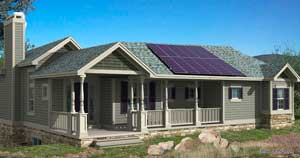Planning an Off-Grid Electric System
Off-grid solar systems operate from the stored energy in a battery bank. Solar panels are used to keep a battery bank charged on a daily basis. Some part of the cabin or tiny house electricity loads, during the daytime, will usually end up running directly off the array via the electricity passing across the battery connectors. At night, the inverter is pulling directly off the batteries. Your solar system has to be sized to support your daily loads and replace the stored energy pulled from the batteries on a daily basis.
Defining Your Load
The first step in determining how many solar panels you will need or how big your inverter should be is to figure out how many watts of power you need per day. Since you determine what you are trying to run, and how long each day you want to run the items, the first place you have to start, after reducing your loads, is to determine your daily energy budge or daily loads. You are going to want to reduce your daily energy demands first before you start to calculate your loads because it is cheaper to save energy than to make energy.

All the Parts Needed; Looking at The Whole System
A typical stand-alone system consists of solar panels usually connected in series of 2 or 3 which product DC electricity from the sun. The solar panels are connected to a charge controller which controls the pace at which batteries are recharged which is connected a 24VDC or 48VDC battery bank. You will then need an off-grid inverter to convert the DC (Direct Current) electricity stored in the battery bank to AC (Alternating Current) electricity which is more commonly used in home appliances. (Click on the 2nd sub-tab above "Planning Design & Installation Tips" to learn more.)
Where to Get Started; Cheaper to Save Energy Than to Make Energy
The trick to off-grid living is energy conservation and efficiency. The starting point in planning your system is to first reduce demand. (Need Tips? Click on the 3rd sub-tab above "Off-Grid Living Energy Conservation") Most people in America can easily cut their electricity consumption in half. Reducing your family's energy consumption by conserving and investing in watt saving home lights and efficient appliances means you are putting your money in your pocket and can substantially reduce the amount of off-grid equipment and or battery bank. As you begin your journey towards freedom from the grid, start by conserving as much as possible first. Its always cheaper to save electricity than to generate electricity. Most off-grid generation is used for lighting, appliances like refrigerators and water pumping. Lighting is the easiest to tackle. Don't stop at compact florescent lights, go all the way to LED which can use 1/6th the watt consumption of compact florescent lighting.
The BIG Questions You Need to Answer First:
- List your loads. How many watts per day does your household consume? The most important challenge in an off-grid system is to balance your energy consumption with your supply of energy required. You cannot begin to do that without first knowing how much energy you need each day.

IE: 5 - 13 watt light bulbs X 5 hours per day = 65 watts. 18 CF refrigerator @ 5 amps x 120VAC = 600 watts x 6 hours per day = 3,600 watts. THIS IS IMPORTANT: When we say "list your loads", we mean all your loads. From the cell phone chargers to a hair dryer. Need Help? If you download the Excel worksheet you will only have to indicate how much of each piece of equipment you have and how long your run it.
- Daily energy budget? It is NOT based on a homes sq. ft. It is NOT based on how many people are living in the house. It is based on the equipment or appliances you want to run and how long each day you typically run them. It does not get more individual than that. The amount of energy you and your family consumes each day will vary among individuals habits and personal choices.
- How many days of limited sun do you want to be able to run? (Days of Autonomy) Typical is a minimum of 3 day to 5 days. The more days, the more energy storage required or the bigger the battery bank needed.
- What is the largest load you expect to run (Watts / Amps / Volts IE: 240V Well Pump @ 9.5 Amps)
- Click on the sub-tab above "Planning Design & Installation Tips" directly below the buySafe emblem to learn more
https://www.bluepacificsolar.com/off-grid.html


 Energy Load Worksheet (Excel)
Energy Load Worksheet (Excel)
ليست هناك تعليقات:
إرسال تعليق